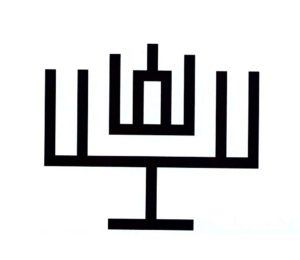We have a new Litvak logo designed by Viktorija Sideraitė-Alon.
The Lithuanian Justice Ministry has granted permission to use the national Lithuanian symbol of the pillars of Gediminas as part of a Lithuanian Jewish Community logo trademark. The patent process for making the Litvak symbol a Lithuanian Jewish Community trademark is being completed right now.

The posts, pillars of columns of Gediminas was used as a coat of arms or insignia by Lithuanian grand duke Vytautas the Great beginning in 1397, following its use by his father grand duke Kęstutis, and has been employed by many other Lithuanian and Polish leaders since then. The Jewish community, living in Lithuania for approximately 700 years no, is an indivisible part of Lithuanian society in the political and historical sense. Many peoples have called Lithuania home over the centuries and the Jewish community has also made significant contributions to the state, the culture and the economy. Incorporating the pillars of Gediminas into a Litvak logo makes perfect sense and corresponds to what the current Lithuanian state openly declares, namely, pride that Lithuania has been open, tolerant and diverse over the centuries.
The sigil-like logo with the pillars of Gediminas also carries within itself semiotic force, calling on society to engage in a good-willed dialogue with the ethnic minority communities. Litvak identification with the historical symbols of Lithuania also reflects an indisputable vector of identity which clearly and without need for interpretation puts on display the priority of the Jews of Lithuania: Lithuania was, is and will be the homeland of Litvaks. Not a station along the way, but the foundation of existence, home, the homeland for which, if needed, we will stand and fight. The symbol with the pillars of Gediminas serves as the stamp and signature of an oath given by the Jews of Lithuania, of the Litvaks, to Lithuania.
During the battles for Lithuanian independence from 1918 to 1920, many Jewish volunteers fought for the freedom of their homeland, Lithuania. Jewish volunteer divisions were even formed. These military units carried their own flags, of which several survive and are conserved at museums. On the flags of the Jewish military volunteers Jewish symbols appear alongside Lithuanian ethnic and national symbols. More than 70 Jewish Lithuanian soldiers and officers were decorated with the Order of the Cross of Vytis for bravery and sacrifice in defending the freedom of Lithuania in the period between the two world wars.
Lithuanians can take pride in the fact Jews recognize the pillars of Gediminas and use them as an expression of Litvak identity. Bearing in mind the number of descendants of Litvaks around the world, understanding how broadly spread around the world the Litvak diaspora is and knowing the influence Jews from Lithuania have in the world, one could only dream of such a unique success and coup in public relations, and for free, as this logo could bring about, this logo which the Lithuanian Jewish Community wants to possess.
The pillars of Gediminas (renamed more properly the pillars of the Gediminids, since there is no evidence grand duke Gediminas actually used the symbol) have been a symbol of state from the 14th century when it was used by grand duke Kęstutis and his son Vytautas. It was adopted by all descendants of Kęstutis as a family symbol or coat of arms. It stood in opposition to the Vytis symbol, which was used by the descendants of grand duke Algirdas, Kęstutis’s brother and Vytautas’s uncle. Later still it was adopted by the Jagiellons (grand duke of Lithuania and king of Poland Jogaila, aka Władysław II Jagiełło, and his descendants) and used alongside the Vytis as twin symbols of statehood, while the Jagiellons’ symbol of the double cross also eventually came to be used as a Lithuanian national symbol. Some believe the pillars of Gediminas symbol was actually inspired by tamgas from Central Asia, brought to Lithuania by the Tartar minority and used to represent family clans and to mark property, among other things.

